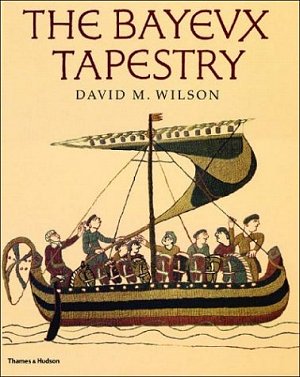 by David M. Wilson
by David M. Wilson
This book is a new edition of a book originally written in 1983, by David M. Wilson. The book is divided into two main sections.
The first section is made up of a series of colour plates of the Bayeux Tapestry. The images are at approx 54% size of the originals and the images were taken in natural light, during the most recent restoration process to be undertaken of the tapestry. This is a significant factor as most other images available were taken through glass while on display, which can change the colour values of the materials in the piece.
The photographs of the tapestry are excellent. It is possible to see many details of the work, including the ability to identify individual stitches and methods of working. Another interesting detail is the fineness of the cloth on which the embroidery is worked, which can be compared to the cloth used to make repairs, near the end of the tapestry.
The second section of the books is a series of text based information which discuss various aspects of the tapestry. Immediately following the images of the tapestry, is a section on the text in the tapestry. A side by side comparision of the original text (Latin) and English translation is provided. Following the inscription is a section of commentary. This is done in a style where black and white photos of the tapestry (on a much smaller scale than the plates of the tapestry in the first section of the book) are annoted with an in depth commentary that explains the story that the tapestry is telling. It also provides historical context for various elements in the tapestry.
The final text section of the book is made up of a series of historical discussions about the world in which the tapestry was made, looking at the political, economic and social influences on the events depicted in the tapestry. There is also an attempt to put the tapestry into is historical context in relation to Anglo-Saxon art of the period. There is specific discussion of architecture, dress and objects. The text sections of the books used endnotes, so it is possible to explore additional resources with some guidance.
My Thoughts:
I really, really like this book. The colour plates are fantastic. The details that can be seen are really amazing. You can literally see every stitch. It also offered a fantastic source for Anglo-Saxon motifs that can be used for embroidery. Once you start looking at the elements, there are alot of things that can be used in different ways.
My only issues with the book are to do with specific elements in the text section. In the area which discusses the tapestry in its art history context, there are several additional illustrations of other period art works. My issue is that the dates for these pieces are not always given and that the photographs are black and white. This is especially annoying with the three additional textile examples that are given. It would have been more useful for these to have been in colour. This can be weighed, however, against the fact that the current location of all examples is given, so further research is possible for the highly motivated.
Details:
- Hardcover: 234 pages ; Dimensions (in inches): 1.10 x 13.82 x 10.32
- Publisher: Thames & Hudson; New edition (April 2004)
- ISBN: 0500251223
- Price: $60 AU











0 comments:
Post a Comment